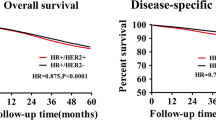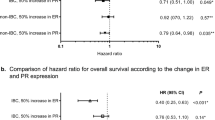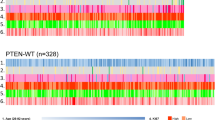Abstract
Purpose
Hormone receptors (HR) status in HER2 + breast cancer (BC) is a recognized stratification factor with relevant clinical implication. According to HR expression, HER2 + BC show different clinical characteristics, treatment sensitivity and prognosis. The interaction between HR and HER2 pathways remains incompletely understood.
Methods
Thirty-four HER2 + BC were included: 18 tumors with HER2+/HR + and 16 with HER2+/HR−. The expression of 770 genes and 13 molecular pathways were evaluated using Nanostring PanCancer Pathway panel performed on FFPE BC biopsies.
Results
Gene expression analysis identified 127 genes with significantly different expression between the two cohorts. 83% of these genes were overexpressed in HER2+/HR− cohort. Globally, 23% of them belonged to PI3K pathway (41 genes), 15% to Trascriptional regulation (26 genes) and 12% to MAPK (22 genes). Regarding pathway expression, PI3K, MAPK and NOTCH were significantly differently expressed between the two groups (p = 0.003, p = 0.0018 and p = 0.02, respectively), all of them were overexpressed in HER2+/HR− tumors.
Conclusions
According to HR status, HER2 + tumors express different pathways profiles: the overexpression of PI3K, MAPK and NOTCH pathways in HER2+/HR− group could justify different survival outcomes and treatment sensitivity. The identification of tumor driver pathways may be a useful instrument for individualized pathway-directed therapies. Further clinical implications are warranted.




Similar content being viewed by others
References
Andre F et al (2014) Everolimus for women with trastuzumab-resistant, HER2-positive, advanced breast cancer (BOLERO-3): a randomised, double-blind, placebo-controlled phase 3 trial. Lancet Oncol 15(6):580–591
Baselga J et al (2012) Lapatinib with trastuzumab for HER2-positive early breast cancer (NeoALTTO): a randomised, open-label, multicentre, phase 3 trial. Lancet 379(9816):633–640
Blows FM et al (2010) Subtyping of breast cancer by immunohistochemistry to investigate a relationship between subtype and short and long term survival: a collaborative analysis of data for 10,159 cases from 12 studies. PLoS Med 7(5):e1000279
Cancer Genome Atlas N (2012) Comprehensive molecular portraits of human breast tumours. Nature 490(7418):61–70
Cheang MCU (2011) PAM50 HER2—enriched subtype enriches for tumor response to neoadjuvant anthracyclines/taxane and trastuzumab/taxane containing regimens in HER2—positive breast cancer. Cancer Res 71:56
Drier Y, Sheffer M, Domany E (2013) Pathway-based personalized analysis of cancer. Proc Natl Acad Sci USA 110(16):6388–6393
Escriva-de-Romani S et al (2018) HER2-positive breast cancer: current and new therapeutic strategies. Breast 39:80–88
Garcia Fernandez A et al (2012) Survival and clinicopathological characteristics of breast cancer patient according to different tumour subtypes as determined by hormone receptor and Her2 immunohistochemistry. a single institution survey spanning 1998 to 2010. Breast 21(3):366–373
Gianni L et al (2010) Open-label, phase II, multicenter, randomized study of the efficacy and safety of two dose levels of Pertuzumab, a human epidermal growth factor receptor 2 dimerization inhibitor, in patients with human epidermal growth factor receptor 2-negative metastatic breast cancer. J Clin Oncol 28(7):1131–1137
Gianni L et al (2012) Efficacy and safety of neoadjuvant pertuzumab and trastuzumab in women with locally advanced, inflammatory, or early HER2-positive breast cancer (NeoSphere): a randomised multicentre, open-label, phase 2 trial. Lancet Oncol 13(1):25–32
Gomez Pardo P (2011) PAM50 intrinsic subtyping and pathologic responses to neoadjuvant trastuzumab-based chemotherapy in HER2-positive breast cancer. J Clin Oncol 29(15):554–554
Hurvitz SA et al (2015) Combination of everolimus with trastuzumab plus paclitaxel as first-line treatment for patients with HER2-positive advanced breast cancer (BOLERO-1): a phase 3, randomised, double-blind, multicentre trial. Lancet Oncol 16(7):816–829
Kirouac DC et al (2016) HER2 + cancer cell dependence on PI3K vs. MAPK signaling axes is determined by expression of EGFR, ERBB3 and CDKN1B. PLoS Comput Biol 12(4):e1004827
Kontomanolis EN (2018) The notch pathway in breast cancer progression. Sci World J 5:2415489
Liu L et al (2009) Novel mechanism of lapatinib resistance in HER2-positive breast tumor cells: activation of AXL. Cancer Res 69(17):6871–6878
Montemurro F, Cosimo SD, Arpino G (2013) Human epidermal growth factor receptor 2 (HER2)-positive and hormone receptor-positive breast cancer: new insights into molecular interactions and clinical implications. Ann Oncol 24(11):2715–2724
Nahta R (2012) Pharmacological strategies to overcome HER2 cross-talk and Trastuzumab resistance. Curr Med Chem 19(7):1065–1075
Omarini C et al (2018) Clinical and molecular predictors of long-term response in HER2 positive metastatic breast cancer patients. Cancer Biol Ther 19(10):879–886
Osipo C (2008) ErbB-2 inhibition activates Notch-1 and sensitizes breast cancer cells to a gamma-secretase inhibitor. Oncogene 27(37):5019–32
Parise CA et al (2009) Breast cancer subtypes as defined by the estrogen receptor (ER), progesterone receptor (PR), and the human epidermal growth factor receptor 2 (HER2) among women with invasive breast cancer in California, 1999–2004. Breast J 15(6):593–602
Pradeep CR et al (2012) Modeling ductal carcinoma in situ: a HER2-Notch3 collaboration enables luminal filling. Oncogene 31(7):907–917
Serra V et al (2011) PI3K inhibition results in enhanced HER signaling and acquired ERK dependency in HER2-overexpressing breast cancer. Oncogene 30(22):2547–2557
Shou J et al (2004) Mechanisms of tamoxifen resistance: increased estrogen receptor-HER2/neu cross-talk in ER/HER2-positive breast cancer. J Natl Cancer Inst 96(12):926–935
Untch M et al (2012) Lapatinib versus trastuzumab in combination with neoadjuvant anthracycline-taxane-based chemotherapy (GeparQuinto, GBG 44): a randomised phase 3 trial. Lancet Oncol 13(2):135–144
Vici P et al (2015) Triple positive breast cancer: a distinct subtype? Cancer Treat Rev 41(2):69–76
Witters L, Engle L, Lipton A (2002) Restoration of estrogen responsiveness by blocking the HER-2/neu pathway. Oncol Rep 9(6):1163–1166
Xia W et al (2006) A model of acquired autoresistance to a potent ErbB2 tyrosine kinase inhibitor and a therapeutic strategy to prevent its onset in breast cancer. Proc Natl Acad Sci USA 103(20):7795–7800
Yarden Y, Pines G (2012) The ERBB network: at last, cancer therapy meets systems biology. Nat Rev Cancer 12(8):553–563
Funding
This study was funded by Progetto Ricerca Finalizzata 2009 (RF 2009-1472600).
Author information
Authors and Affiliations
Corresponding author
Ethics declarations
Conflict of interest
No potential conflicts of interest were declared.
Ethics approval and consent to participate
The Ethical Committee of Azienda Ospedaliero Universitaria Policlinico di Modena approved this study (protocol number: CE 267/15). All patients signed a written, informed consent.
Rights and permissions
About this article
Cite this article
Omarini, C., Bettelli, S., Caprera, C. et al. Differential molecular pathways expression in HER2 positive early breast cancer according to hormone receptor status. J Cancer Res Clin Oncol 145, 821–828 (2019). https://doi.org/10.1007/s00432-018-02833-8
Received:
Accepted:
Published:
Issue Date:
DOI: https://doi.org/10.1007/s00432-018-02833-8




